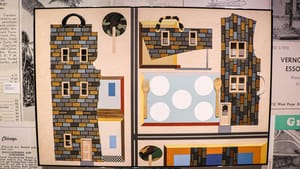Stay in the Loop
BSR publishes on a weekly schedule, with an email newsletter every Wednesday and Thursday morning. There’s no paywall, and subscribing is always free.
Know before you go
The African American Museum in Philadelphia presents Derrick Adams: Sanctuary

Context is everything in Derrick Adams: Sanctuary, now at the African American Museum in Philadelphia. At a glance, the works are lighthearted—deceptively so, because they were inspired by a practical response to racism.
Before the Civil Rights Act of 1964, which prohibited discrimination in public accommodations, Black travelers traversed a minefield of segregationist laws, conventions, and practices that codified hate. It was therefore essential for them to know where they could safely stay the night, have a meal, get the car repaired, or just use a bathroom.
Sanctuary was inspired by The Negro Motorist Green Book, published from 1936 to 1967 to help Black travelers navigate the worst of the Jim Crow era. Which puts an entirely different frame around the cheerful banners, cute cars, and bright lanterns fashioned by Adams (b. 1970), whose Brooklyn-based practice includes painting, sculpture, performance, video, sound, and collage.
Traveling round the year, and the world
In 1936, New York postal worker Victor Hugo Green collected suggestions from Black coworkers to assemble a regional directory of recommendations and friendly businesses. He would continue to publish the Green Book even after retiring from the post office, until his death in 1960.
Layering images of advertisements and page text from the handbook, Adams created Wallpaper (2018), a running print that serves as Sanctuary’s connective tissue. It’s the backdrop for three 2018 banners: En Route 2: Are We There Yet?, En Route 3: Can We Get A Break, and En Route 4: We’ve Come A Looong Way. Each banner bears a fabric silhouette of a car door, with the titular message in the window, as if traced on steamy glass by a bored backseat passenger. The banners hang from wood dowels, each tipped with a black driving glove, as though signaling a change of direction.
The eye continually wanders back to the Wallpaper iterations, to skim cheerful ads for tourist homes, golf courses, service stations, beauty parlors, and new advertisers: “Carry your ad message to over 6 million people who travel the year round.” It turns back the clock to when telephone numbers started with exchanges like RIverside, PResident, and SAcramento, and sales pitches were gently persuasive (“The Friendly Tavern, Good Food, Pleasant Atmosphere.”) Reading about Bob & Lou’s Tavern in Buffalo, New York; the Pythias News Stand in Hot Springs, Arkansas; and Vernon “Shaky” Terry’s Esso station in Malvern, Arkansas, it’s almost possible to forget the underlying reason for the Green Book.

At its height, the book included proprietors in all 50 states, with sections on Canada, the Caribbean, Latin America, Europe, and Africa. It was sold through Black churches, Masonic lodges, the Urban League, the NAACP, and other outlets. The cover of the 1963-64 edition, which sold for $1.95 and was subtitled, “Assured Protection for the Negro Traveler,” featured a smiling Black woman on a beach, hugging a palm tree.
The latest installation
Sanctuary, first mounted in 2018 at the Museum of Arts and Design in New York, grew in part from Adams’s memories of family visits as a child. The exhibit was curated by Dexter Wimberly of Aljira, a Center for Contemporary Art in Newark, with support from Samantha DeTillio of MAD.
For the AAMP iteration, Adams recreated Keep Your Head Down and Your Eyes Open (2021). A room divider is positioned, accordion fashion, in the center of the gallery. A tunnel-shaped opening has been cut in each panel, and a straight board rests like a shelf across the openings, forming a roadway. Small cars made of driving caps set on wooden wheels put-put along. The adorable vehicles invite thoughts of the freedom of the open road, and the excitement of setting off on vacation … until your eye slides back to the Wallpaper images covering the panels, and you remember the ambivalence leisure travel must have held for those consulting the Green Book.
People, living their lives
Born in Baltimore, Adams examines how African American experiences intersect with the broader culture. In Sanctuary, he addresses the 20th century’s increased mobility that came from the rapid development of the auto industry and interstate highway system.
Adams wants to depict Black people simply living, as opposed to marching or protesting. In a 2020 interview at Hudson River Museum, he explained, “When I look around at a party and I see all these people laughing and talking … We should make art about this. This is what art should be made about. We should show this to the world. The world needs to see that we’re in this space, we’re all laughing, having a good time, and people should see that this is something that is a norm.”
Which doesn’t sound too different from something Victor Hugo Green said in 1948:
“There will be a day in the near future when this guide will not have to be published. That is when we as a race will have equal opportunities and privileges in the United States.”
We’ve come a long way, but we’re not there yet.
What, When, Where
Derrick Adams: Sanctuary. Through August 28, 2022, at the African American Museum in Philadelphia, 701 Arch Street, Philadelphia. $10-$14. (215) 574-0380 or aampmuseum.org.
AAMP tickets are timed and to reduce contact, online purchase is encouraged, but not required. Masks are required for visitors aged three and older. Additional information is available here, or by calling AAMP at (215) 574-0380.
Accessibility
AAMP provides barrier-free access for physically disabled guests. For questions or information on specific accommodations, call (215) 574-0380 during museum hours: Thursday-Sunday, 10am-5pm.
Sign up for our newsletter
All of the week's new articles, all in one place. Sign up for the free weekly BSR newsletters, and don't miss a conversation.